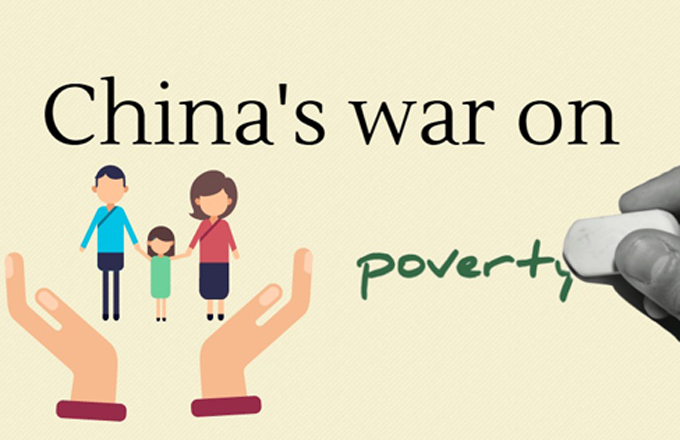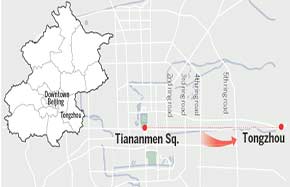China issues white paper on right to development
VII. Accelerating Environment-Friendly Development
China is committed to the concept of environment-friendly development and strives to expedite the country's ecological progress to deliver a more livable and beautiful environment for the people. It aims to make a good eco-environment a focal point for improving people's living standards, and create sustainable development that benefits all the people.
The basic state policy of environmental protection underpins environment-friendly development. In 1973 China convened its first national work conference on environmental protection, and adopted its first Law on Environmental Protection in 1979. In 1983 China made environmental protection a basic state policy. China became the first country in the world to formulate and implement a national sustainable development strategy when it released China's Agenda 21 in 1994. The year 2000 first saw protection of the eco-environment being incorporated into the national economic and social development program. Since 2013 China has been accelerating ecological progress in an all-round way; the CPC Central Committee and the State Council jointly issued "Opinions on Accelerating Ecological Progress" in 2015. A legal system pivoting on energy conservation and environmental protection has been formed, comprising 32 laws, 48 administrative regulations, and 85 departmental rules of the State Council. Currently, there are 14,257 government agencies involved in environmental protection at all levels.
By the end of 2015 national forestry coverage had reached 208 million ha, representing about 22 percent of China's total land area; the vegetation coverage rate of grasslands had reached 54 percent, and the greenery coverage rate of urban built-up areas was 40.1 percent. Nature reserves have been developing in a unified way. Today China has 2,740 nature reserves, covering a total area of 147.03 million ha.
Environmental governance enhances environment-friendly development. A national integrated decision-making mechanism and regional coordination mechanisms have been established for the protection of the eco-environment, forming an environmental governance system jointly implemented by the government, enterprises and the public. Research and development in the technology for environmental protection is improving, and there has been continuous reinforcement of environmental monitoring efforts and pollution control capability.
Air pollution control is making steady progress. The proportion of coal consumption in total energy provision is decreasing year by year, while the contribution of hydropower, wind power, nuclear power, natural gas and other types of clean energy is increasing. Since the beginning of the 11th Five-Year Program (2006-2010), China's energy consumption per RMB10,000 GDP has decreased by 34 percent, saving 1.57 billion tons of coal equivalent, more than half of the energy saved by the whole world in this period. In 2015 the urban wastewater treatment rate reached 91.9 percent, and the pollution-free disposal rate of urban domestic solid waste was 94.1 percent. Urban park green space per capita reached 13.35 square meters.
Ecological economics fosters environment-friendly development. China has completed a system of working centers for agricultural environmental protection, consisting of two at national level, 33 at provincial level, more than 300 at prefectural level, and more than 1,700 at county level. In the drainage basins of Taihu Lake, Chaohu Lake, Erhai Lake, the Three Gorges reservoir region, and other major drainage basins requiring pollution prevention and control, model areas of diffuse agricultural pollution prevention and control have been established, and 106 national model areas of eco-friendly prevention and control of plant diseases and pests have been set up, covering more than 33 million ha of farmland. More than 100 counties in two batches have been built into national models of ecological farming, prompting the development of over 500 provincial-level model counties. More than 2,000 model sites of ecological farming have been completed.
The agricultural hi-tech industry places its emphasis on long-term development. Field water application efficiency in agricultural irrigation has been raised to 0.536. Investments in technological upgrading have been reinforced, and efforts have been made to promote the new industrial development. Between January and September 2016, investments in industrial technological upgrading amounted to RMB6.6 trillion, an increase of 13.4 percent over the same period of 2015 and accounting for 40 percent of all industrial investments. The tertiary sector has been encouraged and supported to develop faster and generate more green GDP. The expanding Internet economy recorded a turnover of RMB3.88 trillion in the online retail industry in 2015, an increase of 33.3 percent over 2014.
Policy support bolsters environment-friendly development. The state has made active efforts to protect the sustainable development of ecologically fragile areas through integrated planning, targeted treatment, and the ecological compensation mechanism, creating a virtuous cycle for regional eco-environments. Ecological areas of medium fragility make up 55 percent of China's land area, with two thirds concentrated in the western regions. In 2005 the State Council prescribed restrictive development in ecologically fragile areas. The "Outline for the Conservation of Ecologically Fragile Areas in China (2009-2020)" was promulgated in 2008. By 2015 environmental impact assessment had been implemented in all ecologically fragile areas, a 30 percent increase of targeted areas had been brought under the strategy, and models of the ecological industry have been promoted in ecologically fragile areas.
Commitments to international conventions propel environmentally-friendly development. China was among the first countries to formulate and implement a national climate change plan, and pledged to achieve its 2020 goals laid out in the "National Plan on Climate Change (2014-2020)" and 2030 goals set out in the "Enhanced Actions on Climate Change: China's Intended Nationally Determined Contributions" released in 2015. Over the years, China has taken effective policy actions to honor its commitments. Moving along the path toward low-carbon development, China enacted the "National Plan for Reducing Ozone-depleting Substances" and achieved ahead of schedule its first-stage hydrochlorofluorocarbons (HCFCs) phase-out goal as part of its commitment to the "Montreal Protocol on Substances that Deplete the Ozone Layer." China's reduction of ozone-depleting substances accounts for approximately half of the total reduction by developing countries. China has eliminated the production, use, and import and export of 17 of the 26 types of persistent organic pollutants listed in the "Stockholm Convention on Persistent Organic Pollutants," and reduced the dioxin emissions of three industries that are major emitters of dioxins by more than 15 percent. Furthermore, the state has established the National Committee for Biodiversity Conservation, enacted the "China Biodiversity Conservation Strategy and Action Plan (2011-2030)" and signed the Minamata Convention on Mercury. China is an active and constructive participant in international talks on climate change, and makes robust efforts to bolster the United Nations Framework Convention on Climate Change. China has made significant efforts in moving the Paris Agreement on greenhouse gas emissions mitigation toward adoption and taking effect, making it one of the fastest major international agreements ever to enter into force and further contributing to the world's sustainable development.



















